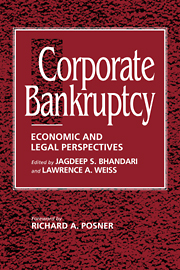Book contents
- Frontmatter
- Contents
- List of tables and figures
- Foreword by the HONORABLE RICHARD A. POSNER
- Preface
- Part I The role of credit
- Part II Bankruptcy as a reflection of the creditors' implicit bargain
- Part III Beyond the basic creditors' bargain
- Part IV Workouts or bargaining in the shadow of bankruptcy
- Part V Alternatives to bankruptcy and the creditors' bargain
- 21 Corporate control and the politics of finance
- 22 The uneasy case for corporate reorganizations
- 23 Bankruptcy and debt: A new model for corporate reorganization
- 24 A new approach to corporate reorganizations
- 25 Debtor's choice: A menu approach to corporate bankruptcy
- 26 Is corporate bankruptcy efficient?
- 27 The voting prohibition in bond workouts
- 28 Financial and political theories of American corporate bankruptcy
- Part VI Experience of other countries
- Index
23 - Bankruptcy and debt: A new model for corporate reorganization
Published online by Cambridge University Press: 10 December 2009
- Frontmatter
- Contents
- List of tables and figures
- Foreword by the HONORABLE RICHARD A. POSNER
- Preface
- Part I The role of credit
- Part II Bankruptcy as a reflection of the creditors' implicit bargain
- Part III Beyond the basic creditors' bargain
- Part IV Workouts or bargaining in the shadow of bankruptcy
- Part V Alternatives to bankruptcy and the creditors' bargain
- 21 Corporate control and the politics of finance
- 22 The uneasy case for corporate reorganizations
- 23 Bankruptcy and debt: A new model for corporate reorganization
- 24 A new approach to corporate reorganizations
- 25 Debtor's choice: A menu approach to corporate bankruptcy
- 26 Is corporate bankruptcy efficient?
- 27 The voting prohibition in bond workouts
- 28 Financial and political theories of American corporate bankruptcy
- Part VI Experience of other countries
- Index
Summary
General Themes
The core determinations made in a reorganization under chapter 11 of the Bankruptcy Code are simply stated: Who gets how much? What will the reorganized capital structure be? To resolve these simply stated questions, bankruptcy courts now loosely oversee a lengthy bargaining process that is widely thought to be cumbersome, costly, and complex. The strain of extended financial stress – particularly in a bankruptcy proceeding – results in lost sales when customers seek a more secure supply source, in consumption of valuable management time spent resolving financial difficulties, and in foregone opportunities to obtain and to implement new projects. Additional costs are borne by the employees, customers, and suppliers of the bankrupt company, as well as the communities in which it operates.
Three principal characteristics seem desirable for a corporate reorganization mechanism: speed, low cost, and a resulting sound capital structure. Other desirable characteristics are accuracy in valuation and compensation, predictability, and fairness. Accuracy and predictability diminish the uncertainty of the results of bankruptcy reorganizations, facilitating investment in risky but worthwhile enterprises before a bankruptcy occurs. Speed and low cost help diminish the deadweight costs of the bankruptcy when it does occur.
Three general mechanisms might be considered to accomplish a corporate reorganization:
a bargain among creditors and stockholders (i.e., a workout that occurs outside the bankruptcy court or after the filing of a bankruptcy petition), but even then with minimal court supervision;
litigation in which the court imposes a solution and capital structure; and
although rarely even noted as a serious possibility, use of the market.
- Type
- Chapter
- Information
- Corporate BankruptcyEconomic and Legal Perspectives, pp. 351 - 369Publisher: Cambridge University PressPrint publication year: 1996



